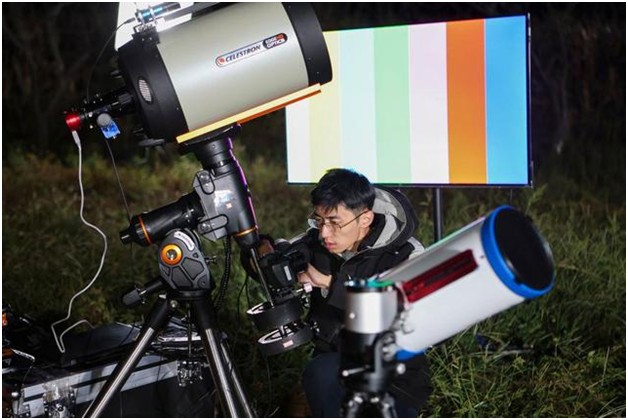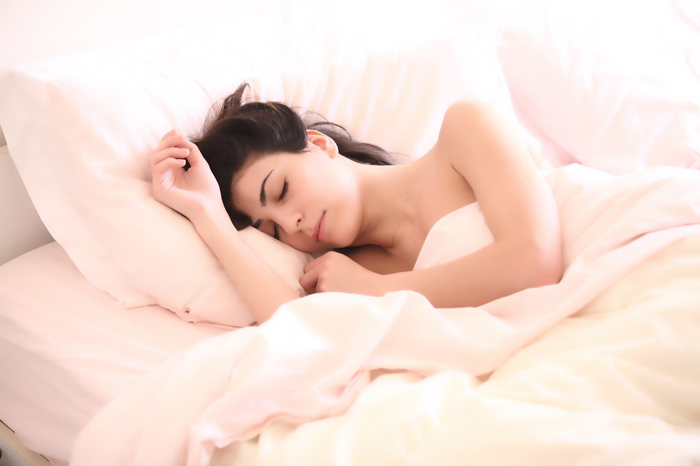> Chinese astronomy enthusiast's 'chasing project'
90后追星“青年”为中国空间站拍“写真”

[Photo/Xinhua]
Liu Boyang, a post-1990 astrophysics doctor and astronomy enthusiast, took hundreds of thousands of photos of the China Space Station (CSS) with a self-developed automatic tracking script for optical recognition.
中国90后天体物理学博士、天文爱好者刘博洋用自主开发的光学识别自动跟踪脚本,拍摄了数十万张中国空间站的照片。
Common methods for shooting celestial bodies are not suitable for taking higher-precision photos of the space station.
常用的天体拍摄方法不适合拍摄更高精度的空间站照片。
Given some of the disadvantages of the current methods, Liu came up with his own plan – writing an automatic tracking script for optical recognition, then manually finding the space station and framing the tracking based on the control of proportional, integral and differential units.
考虑到现有方法的一些缺点,刘博洋提出了自己的方案——编写一个光学识别的自动跟踪脚本,然后手动找到空间站,并基于比例、积分和微分单元的控制框架跟踪。
It took a lot of trial and error before Liu finally fixed the bug and verified the function of the program this April.
经过大量的尝试和失败,他终于在今年4月修复了这个错误并验证了该程序的功能。
Starting in April, Liu and his team have been chasing the space station and recorded over 50 configuration changes from Beijing and South China's Hainan province. He captured the Tianzhou-3 cargo spacecraft's separation from its core module, the Shenzhou-14 spacecraft's launch, and the Mengtian Lab Module's docking with the core module, among others.
自从4月拍下中国空间站开始,刘博洋和团队半年来开启“逐天模式”。从天舟三号撤离空间站,到天舟四号、神舟十四号发射,再到问天舱、梦天舱对接成功,刘博洋一行人在北京、海南等多地,50余次追拍中国空间站特写影像并把这些构型变化完整记录下来。
When asked about his plan for the future, the 32-year-old astronomer said that he had been preparing himself to record the Tianzhou-5 cargo spacecraft and Shenzhou-15 spaceflight, and it would be his lifetime commitment to explore every possibility to show people the sky and help them learn about space and the universe.
当被问及他的未来计划时,这位32岁的天文学家说,目前他正在准备天舟五号货运飞船和神舟十五号载人飞船的跟拍计划,这将是他毕生的承诺,探索各种可能性,向人们展示天空,帮助他们了解空间和宇宙。
> Why you twitch when you sleep
为什么有人会睡觉时突然抖一下?

[Photo/Pexels]
Hypnic jerks — also called sleep starts — are sudden, involuntary muscle contractions you may experience as you are falling asleep.
入睡抽动——也称为睡眠启动——是你在入睡时可能会经历的突然的、不自主的肌肉收缩。
Hypnic jerks are a type of myoclonus, which is a category of rapid, involuntary muscle movements.
入睡抽动是一种肌阵挛,即快速而不自主的肌肉运动。
Hiccups are another type of myoclonus.
打嗝也是肌阵挛的一种。
Hypnic jerks are associated with a rapid heartbeat, quickened breathing, sweat, and sometimes "a peculiar sensory feeling of 'shock' or 'falling into the void' ".
入睡抽动通常伴随着心跳加快、呼吸加快、出汗,有时还伴有“一种'震惊'或'坠入虚空'的奇特感官感觉”。
It can also be accompanied by a vivid dream experience or hallucination.
有时也伴随着生动的梦境或幻觉。
A higher occurrence is reported in people with irregular sleep schedules.
据报道,作息不规律的人有更高概率伴有入睡抽动。
Moreover, when they are particularly frequent and severe, hypnic jerks have been reported as a cause of sleep-onset insomnia.
此外,当症状特别频繁和严重时,还会导致入睡性失眠。
Researchers do not know for sure what causes hypnic jerks, but they have a few theories.
研究人员还不确定是什么原因导致入睡抽动,但他们有一些理论。
Hypnic jerks and other types of myoclonus start in the same part of your brain that controls your startle response.
入睡抽动和其他类型的肌阵挛始于大脑中控制惊吓反应的同一部分。
When you fall asleep, researchers suspect that a misfire sometimes occurs between nerves in the reticular brain stem, creating a reaction that leads to a hypnic jerk.
研究人员怀疑,当你入睡时,网状脑干的神经之间有时会发生错误放电,产生一种反应,导致入睡抽动。
Hypnic jerks can be unsettling, but they’re not dangerous.
入睡抽动和其他类型的肌阵挛始于大脑中控制惊吓反应的同一部分。
In fact, they’re considered a normal part of falling asleep.
事实上,它们被认为是入睡的正常部分。
Up to 70% of people experience hypnic jerks.
高达70%的人经历过睡眠痉挛。
They can be annoying and disrupt the sleep of you or your partner.
入睡抽动可能很烦人,会扰乱你或你的伴侣的睡眠。
While it is possible that a particularly violent jerk could lead to a minor injury, it’s not common.
虽然特别剧烈的抽搐可能会导致轻微的伤害,但这种情况并不常见。
Hypnic jerks are a normal, albeit unpredictable, part of the experience of falling asleep.
入睡抽动是入睡体验的正常部分,尽管不可预测。
It’s unlikely that you’ll be able to completely eradicate them from your life.
你不太可能从生活中完全根除它们。
However, you can reduce their frequency and intensity, and improve your sleep at the same time, with a few relatively simple techniques.
然而,你可以通过一些相对简单的技巧,减少它们频率和强度,同时改善睡眠。
Go to bed and wake up at the same time every day, even on weekends.
按时上床睡觉和起床,即使在周末也是如此。
Make your bedroom as dark and quiet as possible, using blackout curtains or a white noise machine if needed.
让卧室尽可能保持黑暗和安静,必要时使用遮光窗帘或白噪音机。
Stop using electronics at least one hour before bed.
睡前至少一小时停止使用电子产品。
Find more audio news on the China Daily App.